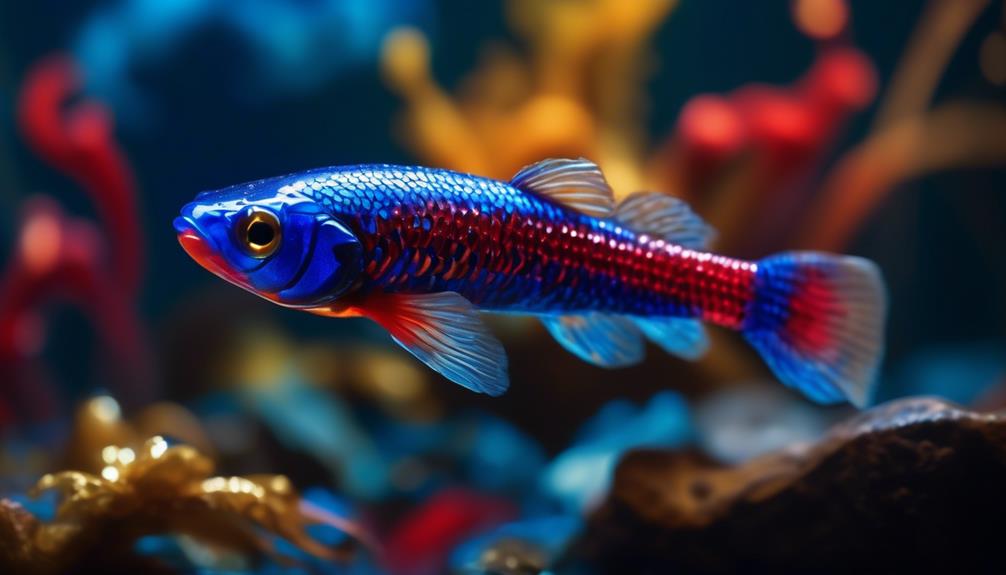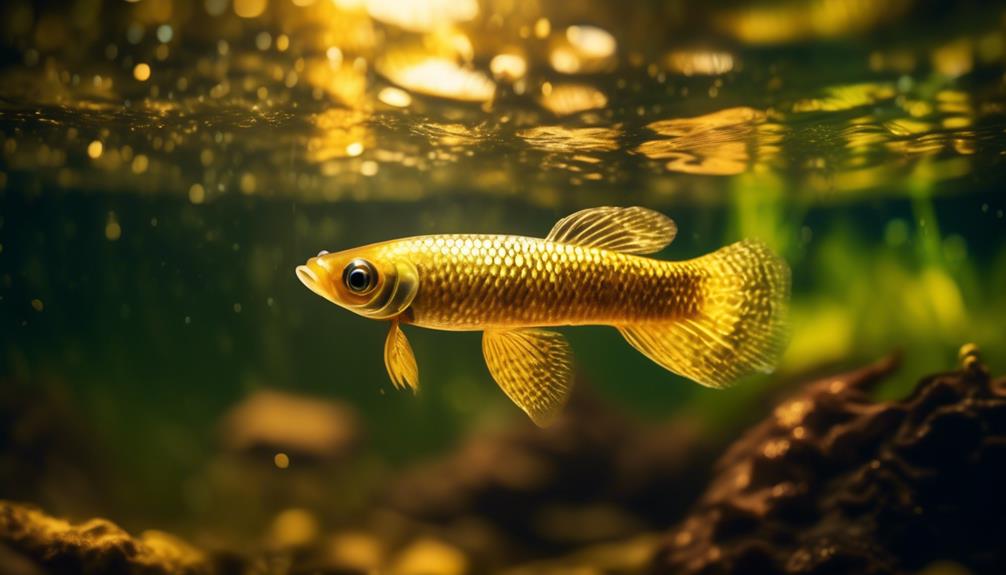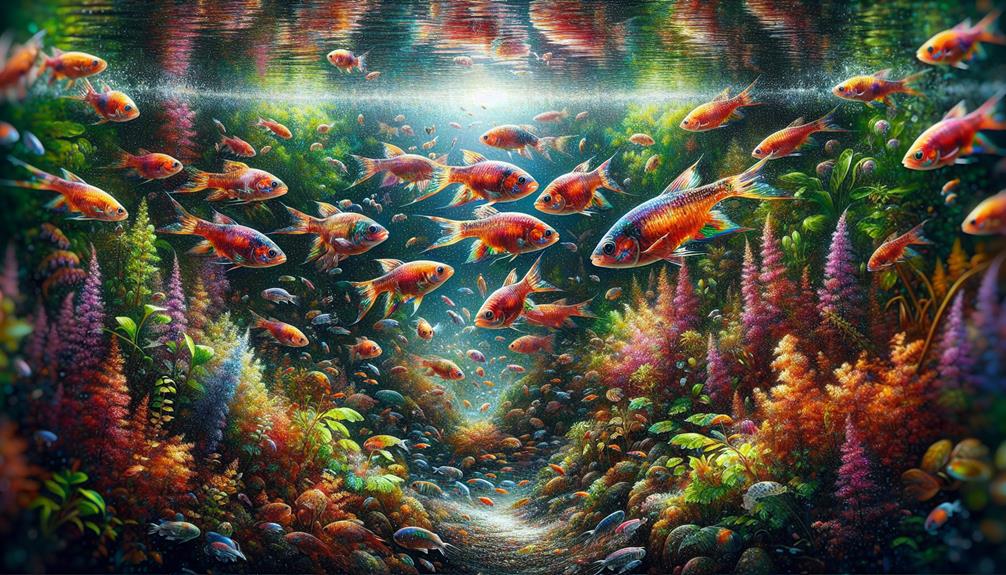Welcome to the captivating world of killifish, where exotic beauty and vibrant colors come together in a mesmerizing display. These small freshwater fish are renowned for their unique patterns and striking hues, making them a favorite among aquarium enthusiasts.
From the distinctive bands of the Clown Killifish to the bold orange body of the Orange Australe Killifish, each species holds its own allure.
But there's more to discover beyond their appearance. Join us as we delve into the fascinating characteristics and behaviors of these colorful creatures, and prepare to be enthralled by the wonders that await.
Key Takeaways
- Killifish come in a variety of vibrant colors and patterns, making them a visually appealing choice for aquarium enthusiasts.
- Different species of killifish have unique breeding habits and behaviors, such as courtship displays and egg scattering.
- Tank setup and requirements vary depending on the species, with factors like tank size, pH levels, and temperature needing to be considered.
- Killifish can be peaceful tank mates, but it's important to avoid pairing them with fin-nipping or aggressive fish.
Clown Killifish: The Banded Panchax
The Clown Killifish, scientifically known as Epiplatys annulatus, is a vibrant and captivating species of fish that is commonly referred to as the Banded Panchax due to its distinct bands of dark brown and tannish-yellow. This small fish, reaching a size of only 1.4 inches (3.5 cm), is particularly known for its striking flame-like tail, which is more prominent in males.
Understanding the breeding habits of the Clown Killifish is essential for successful reproduction. They are annual fish, meaning they complete their life cycle within a year. Males attract females by displaying their colorful fins and engaging in courtship displays. Females lay their eggs in plants, and once fertilized, the eggs can be removed and placed in a separate container for incubation.
When it comes to tank setup, creating the perfect environment for Clown Killifish in a nano tank requires attention to detail. A 5-gallon tank is sufficient for these small fish, but it should be densely planted to provide hiding places and simulate their natural habitat. The water parameters should be kept stable, with a pH range of 6.5-7.5 and a temperature of 72-78°F (22-26°C).
Providing a well-balanced diet consisting of high-quality flakes, frozen or live foods will ensure the optimal health of these beautiful fish.
Orange Australe Killifish: A Lyretail Beauty
With its bold orange body, red spotting, and extended tail tips, the Orange Australe Killifish, scientifically known as Aphyosemion australe, is a truly captivating and beautiful species of fish.
Here are four fascinating facts about this lyretail beauty:
- Breeding habits: The Orange Australe Killifish is known for its unique breeding behavior. Males perform courtship displays, showcasing their vibrant colors and impressive fins to attract females. The female lays her eggs in dense vegetation or on the substrate, and the male fertilizes them. These eggs have a unique ability to survive in a dormant state known as diapause until favorable conditions trigger their hatching.
- Natural habitat: This species is native to the coastal regions of western Africa, specifically in the Niger Delta and parts of Cameroon. It inhabits shallow temporary pools, flooded areas, and swamps with dense vegetation. These habitats provide the necessary hiding places and food sources for the Orange Australe Killifish.
- Feeding habits: In the wild, this species primarily feeds on small invertebrates such as insects, crustaceans, and worms. In captivity, they can be fed a varied diet consisting of high-quality flake or pellet food, supplemented with live or frozen foods like brine shrimp, daphnia, and bloodworms. Providing a diverse diet helps maintain their vibrant colors and overall health.
- Tank requirements: To ensure the well-being of the Orange Australe Killifish, a tank of at least 10 to 20 gallons is recommended. It should be decorated with plenty of plants, driftwood, and hiding spots to mimic their natural habitat. The water temperature should be kept between 72-78°F (22-26°C), with a slightly acidic to neutral pH range of 6.0-7.5. Regular water changes and a well-maintained filtration system are essential for their thriving.
Gardneri Killifish: A Colorful Display

Known for their vibrant colors and captivating displays, the Gardneri Killifish, scientifically known as Fundulopanchax gardneri, is a species that truly showcases a colorful display in the aquarium. These magnificent fish are native to West Africa and have become a popular choice among aquarium enthusiasts.
The Gardneri Killifish is a small species, reaching a size of about 2.5 inches (6 cm). The males of this species display a range of colors, from pale pink to blue-green to a purple sheen with red dots. To further enhance their beauty, they have long, flowing fins that add an extra level of elegance to their appearance.
In terms of breeding behavior, the Gardneri Killifish is relatively easy to breed compared to other species of killifish. They are egg-layers and will scatter their eggs among plants or other substrate in the aquarium. It is recommended to provide plenty of aquarium plants for shelter and spawning purposes.
As for tank mates, the Gardneri Killifish is generally peaceful and can be kept with other small, non-aggressive fish. However, it is important to avoid keeping them with fin-nipping species or aggressive fish that may harm or stress them.
Blue Gularis Killifish: The Majestic Giant
The Blue Gularis Killifish, scientifically known as Fundulopanchax sjoestedti, is a magnificent and captivating species that commands attention with its vibrant colors and impressive size. Here are four fascinating facts about this majestic giant:
- Potential mates for blue gularis killifish: The males of this species are predominantly blue with red dots and vertical stripes. They are known for their striking appearance, making them highly sought after as potential mates.
- Habitat requirements for blue gularis killifish: These fish require a 29-gallon aquarium or larger with plenty of cover. They prefer a carnivorous diet of bloodworms, brine shrimp, and smaller fish. Creating a suitable habitat with hiding spots and a varied diet is crucial for their well-being.
- Impressive size: Blue Gularis Killifish is the largest killifish on the list, reaching 4-5 inches (10-13 cm) in length. Their size adds to their majestic presence in any aquarium.
- Vibrant colors: With their predominantly blue bodies adorned with red dots and vertical stripes, Blue Gularis Killifish are a stunning sight to behold. Their vibrant colors make them a popular choice for fish enthusiasts seeking a visually striking addition to their aquarium.
Golden Wonder Killifish: A Splash of Gold

The Golden Wonder Killifish, scientifically known as Aplocheilus lineatus, is a stunning fish that adds a splash of gold and elegance to any aquarium. This beautiful golden-yellow fish can grow up to 3-4 inches (8-10 cm) in length, making it a captivating centerpiece in a tank.
One potential discussion idea for this subtopic is breeding golden wonder killifish. Breeding these fish requires specific tips and techniques to ensure success.
Another idea is creating a stunning golden themed aquarium with golden wonder killifish. With their vibrant color, they can be the focal point of a themed tank that exudes elegance and beauty.
The Golden Wonder Killifish is a hardy species that can adapt to a wide range of water parameters, making it suitable for both beginner and experienced aquarists.
Frequently Asked Questions
What Is the Lifespan of Killifish in General?
The lifespan of killifish varies depending on the species, but on average, they live for about 2 to 3 years. However, some species can live up to 4 or 5 years with proper care. Their breeding habits are diverse and fascinating, with many species exhibiting unique reproductive strategies.
Can Killifish Be Kept in a Community Tank With Other Fish Species?
Killifish can be kept in a community tank with other fish species, but compatibility depends on the specific species involved. Some killifish may display aggressive breeding behavior, so it is important to choose compatible tank mates to ensure a harmonious community.
Are Killifish Suitable for Beginners or Do They Require Advanced Care?
Beginner friendly care for killifish involves providing a suitable tank size, proper diet, and stable water conditions. Advanced care requirements for killifish include specialized breeding techniques, managing water chemistry, and creating specific habitat conditions for different species.
How Often Should Killifish Be Fed and What Types of Food Do They Prefer?
Killifish should be fed small amounts of high-quality food multiple times a day. They prefer a varied diet consisting of live or frozen foods like bloodworms, brine shrimp, and daphnia. Feeding frequency can be adjusted based on the fish's appetite and growth.
Do Killifish Require Specific Water Parameters or Can They Adapt to a Wide Range of Conditions?
Killifish, while adaptable to a wide range of water parameters, can benefit from specific conditions to enhance their coloration. Factors such as pH, temperature, and water hardness can influence the vibrancy of their colors, making them more appealing to breeders and enthusiasts.
Conclusion
In conclusion, the world of killifish offers a mesmerizing display of vibrant colors and unique patterns. These exotic freshwater fish, such as the Clown Killifish, Orange Australe Killifish, Gardneri Killifish, Blue Gularis Killifish, and Golden Wonder Killifish, bring a splash of beauty to any aquarium. Their striking appearances and captivating behaviors make them a popular choice among hobbyists.
As an interesting statistic, it is estimated that there are over 1,000 known species of killifish, showcasing the incredible diversity and allure of these captivating creatures.

